Abstract
Eggs from poultry are included in the food consumer basket, which actualizes the research issues of this market segment, reaching its predicted values. The share of Russia in the volume of world production fluctuates within 3%. Food eggs are imported mainly by Belarus. Export interventions of eggs and products of their processing expand the geography of foreign trade transactions, but remain niche so far. The study of egg self-sufficiency per capita in the context of regions showed the possibility of increasing its volume by levelling regional levels. Similarly, niche segments of this target market were identified based on an increase in the consumption of eggs and products of its processing, an increase in the share of eggs obtained from other types of poultry, as well as an increase in the volume of functional, organic products, and exports. The implementation of these reserves provides for the availability of mathematical tools for assessing market potential. Proceeding from this message, the article considers the term of the potential of the market, gives a classification of the main approaches to its definition, proposes a model of the structural components of the market potential of egg poultry farming and a methodology for assessing the perpectives of poultry products, reaching the predicted values.
Keywords: Assortment portfolio, valuation methodology, market potential, target egg market, egg poultry farming
Introduction
Poultry farming is a leading sub-branch of animal husbandry, providing the country's population with high-quality protein products of animal origin. Among the products included in the food basket are eggs from poultry. Currently, the volume of egg production in Russia has a positive trend. In the volume of world production, the share of our country is about 3%, which corresponds to the sixth place (Fisinin, 2019). Regarding the resources of eggs and egg products in general, this target market can be assessed as self-sufficient, which is explained by the insignificant share of imported products against the background of growth in domestic production. At the same time, the volumes of exported products for eggs and products of its processing can be attributed to the number of niche ones (Harutyunyan, 2010).
Taking into account the opinions of a number of scientists, the chicken egg market is to a certain extent classified as oversaturated, while other authors believe that there is significant growth potential for this target segment both in the domestic and foreign markets (Cherkasov, 2012; Dankvert & Holmanov, 2014). In the process of an analytical study of the market potential of eggs, the point of view of the latter was confirmed. Possible reserves for expanding the market potential of eggs and products of its processing include an increase in the consumption of eggs by the population, the production of eggs from other types of poultry (guinea fowl and quail), the share of functional and organic products, processing, and export.
A review of the market for eggs and products of its processing showed the presence of problem areas that impede its development (Kakushkin, 2017). For the adequacy of the management decisions made regarding the prospects for expanding the market for eggs and products of their processing, it is advisable to have a methodological toolkit for assessing its potential. However, the research of existing theoretical perspectives in the assessment of market potential (MP) in other sectors of the national economy shows that none of them can be fully used in industrial poultry farming.
The above arguments indicate the relevance of this methodological base in relation to the industry, including the target market for eggs and products of its processing.
Problem Statement
The problem under study is that in order to assess and predict the MP of egg poultry farming, it is required to develop a mathematical toolkit for its assessment and, taking into account the proposed scheme for expanding the assortment portfolio, determine the predicted value for the types of produced (main, accompanying and by-products) products.
Research Questions
- Assessment and forecast of the MPof egg poultry farming.
- Development of mathematical tools.
Purpose of the Study
The purpose of the study is to develop a mathematical toolkit for assessing the MPof egg poultry farming, reaching the predicted values.
Research Methods
Dialectical approach, methods of induction and deduction, methods of systemic, structural and comparative analysis, economic and mathematical methods.
Findings
The study was carried out in a comprehensive manner, including theoretical, methodological and applied aspects of approaches and models to assess the market potential. It was found from the results of a review of various methods that the most common is the assessment of the MP of an enterprise. It can be stated that there is no information on both the methodological and practical assessment of the of products. This gave an understanding of the need to generalize scientific results according to the existing methods in order to identify the local elements of interest to us, touched upon in a particular method. Their systematization made it possible to determine three main approaches to assessing the MP of an enterprise, namely, resource, resultant and predictive (Barancheev & Strizhov, 1996; Nekrasov, 2009; Valov, 1999).
The resource concept provides for the determination of the value of the potential by the volume of resources in cost, labour and physical terms. With the resource approach, it is very difficult to determine the real possibilities of the commodity market. According to this approach, only material prerequisites and opportunities are recorded.
The essence of the resultant concept of assessing the MP of an enterprise consists of indicators of the efficiency of an economic entity. This approach has a point of approaching the reliability of such an assessment, but it also has drawbacks, since there is no single approach to the selected performance criteria and algorithms for their calculation in relation to the market.
Regarding the predictive concept in the implementation of the MP of the enterprise, then its basic feature is the strategic plan of its development. Considering that, as a rule, strategic plans are of a long-term nature, they cannot fully respond promptly to changes in the market in the short and medium term.
The arsenal of these concepts for assessing the MP of an enterprise does not exhaust all their diversity, but gives an idea of the vector of development of these concepts regarding the poultry production and their products.
The most promising existing methods for assessing the MP of an enterprise are the approaches presented by Popov (2002), considering this assessment from the point of view of commodity policy. The potential of each assortment position is preliminarily determined, adjusted for the corresponding significance and the summation of all terms. The proposed approach to assessing the MP of an enterprise has a number of positive positions, such as planning product development, updating it, brand name and the degree of product response to the market situation.
By integrating the results of studying the methodological aspects of assessing the MP of an enterprise, one can state the existence of problem areas that need to be improved from the standpoint of selecting estimated indicators, their weight values, determining target markets and methodological aspects of their interaction. Moreover, all three concepts have contradictions regarding the analysis of real market opportunities for realizing MP and the available arsenal in science and practice of the tools for such an assessment. Consequently, the development of a methodology for assessing the MP of products in the poultry production is an integral part of the theoretical and methodological mathematical model that allows calculating the predicted values of the MP of the industry's products for the future.
The main point in developing a methodology for assessing MP was to comprehend the meaningful characteristics of this given economic category. Scientific research on this issue consisted in generalizing the accumulated theoretical experience regarding each component of this concept. It must be admitted that the concept of MP is given from the standpoint of an industry, an enterprise, but not a product, and there is an identification with other types of potentials (economic, marketing, etc.). To reach the concept of the MP of poultry, a benchmark was chosen as the basis, namely, the competitiveness of the product, which is the core of the MP of the product. This point of view is also shared by a number of authors who consider this economic category in the relationship between the capabilities of the enterprise and the competitiveness of the products they produce to meet the needs of consumers in a market environment (Cherkasov, 2012). The whole set of researched opinions of scientists on MP was a platform for developing a classification according to certain criteria.
The main approaches to determining the MP based on the hierarchy of the levels of its implementation are highlighted:
1. The company's MP can be divided to different shares depending on the maximum possibility of the demand. This demand is satisfied by the enterprise in the framework of aggregate demand (or sales volume in this industry). It is divided into: a) MP enterprise, which can be calculated from the existing share of the enterprise in the aggregate demand of the industry products in the sales volume; b) MP of the enterprise for maximum possible sales volume which is calculated from the maximum industry possibilities of the enterprise at the market; c) the MP of the enterprise, calculated based on the existing share of the enterprise in the total demand for the industry's products (in sales), as well as taking into account the production capabilities of the enterprise (including its competitiveness);
2. The MP of the industry's products according to the criterion of the maximum possible volume of satisfied needs is divided into: a) the MP of the industry, calculated according to the volume of absolute needs (according to rational, medical consumption rates); b) the MP of the industry, calculated according to the volume of relative, solvent needs (according to the maximum possible demand, based on the indicators of the economic availability of food to the population - cash income, consumer prices); c) the MP of the industry, calculated based on the existing share of domestic producers in the total demand for the industry's products.
As Eremeeva and Roiter (2019) say:
Taking into account this classification and analysis of the concept of "MP of an enterprise", the following interpretation of the MP of products is formulated as the maximum capacity of target markets, formed on the basis of the law of diminishing marginal utility and the theory of consumer choice. The next principal task was to define target markets for poultry products. The conceptual approach to the implementation of this task was to build a model of MP with details of its constituent elements. The sectoral model of the relationship between business entities in the production of poultry products was developed based on an analysis of the life cycle of obtaining products and taking into account the hierarchy of the sectoral structure of poultry entities. (p. 37)
In this case, the generally accepted scheme of a 4-line cross of poultry was used. Its presentability is shown in Figure 1.
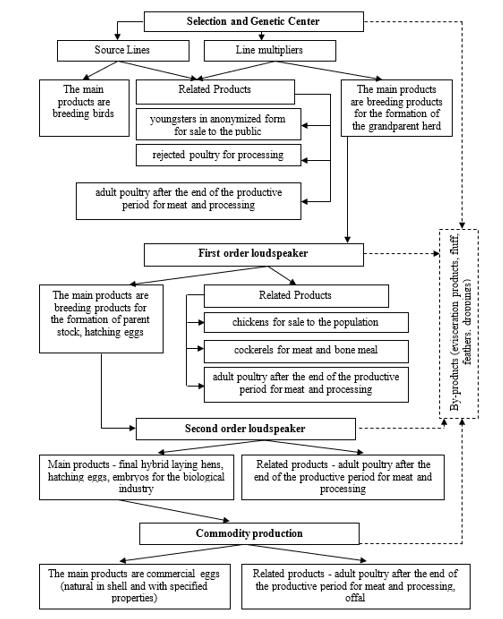
It can be seen from the model that the main product of egg poultry farms is a commercial egg, and the accompanying laying hen after the end of the productive period in the form of meat, by-products and raw materials for processing (Eremeeva et al., 2020). There are separate models of the MP for processing poultry products. At egg enterprises, they are built depending on the intended purpose of its implementation (Figure 2).
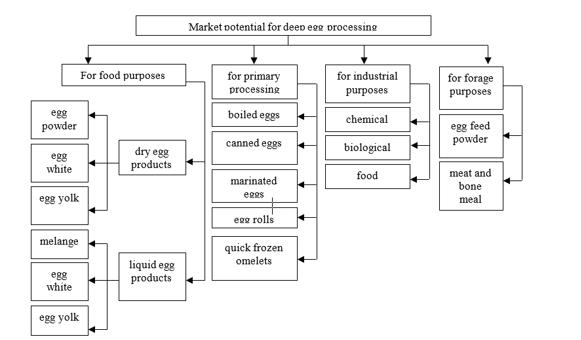
In the structure of this model, at each hierarchical level of production, by-products are also identified, which have significant growth potential and access to this target market segment (Figure 3).
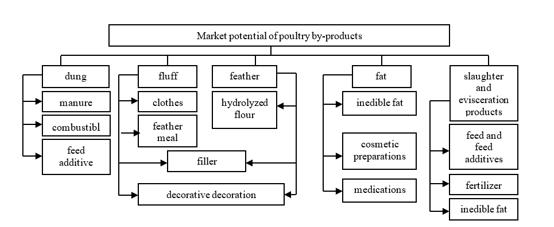
The refined conceptual apparatus of the MP of poultry products, and the developed conceptual model of the relationship between the subjects of the industry in the production of products, gave an understanding of the meaningful characteristics of this economic category and the diversity, breadth of products produced by the industry, which served as the basic platform in developing a methodology for assessing the MP of poultry products (Roiter et al., 2019).
Algorithmization of the methodology for assessing the MP of poultry products was carried out in accordance with the characteristics of obtaining products at each hierarchical level, starting with commercial production (Eremeeva et al., 2019; Roiter et al., 2019). Let us illustrate the sequence of steps for calculating the values of market potential. At the first stage, we determine the MP of commercial poultry products.
We begin the construction of the algorithm by determining the volume of commercial products, for this it is necessary:
where: РПТПяп – MP of marketable products in egg poultry farming, pieces of eggs; Nрац – rational norms of consumption of poultry eggs recommended by the Ministry of Health and Social Development of the Russian Federation, kg; Чн – population size, people; – geometric mean of competitiveness coefficient; – mean square coefficient of cross elasticity; Э – export value, kg; Э – change in the value of exports for the future, share; И – import value, kg; И – change in the value of imports for the future, share.
To ensure a given volume of edible eggs and egg products, the livestock of the final hybrid is calculated as a source of its provision according to the following formula:
РПТПя = РПТПяп/Як-н [heads]
where: РПТПя is the MP of marketable products in egg poultry farming, heads; Як-н - average egg production of one laying hen, pieces per year
Calculation of the parent herd population, which provides the final hybrid livestock, has the following calculation algorithm:
where: Ия – percentage of suitability of eggs for incubation; Вц – percentage of chicks hatching from hatching eggs; 0.5 – percentage of females in chicks hatched; 2 – selection pressure level; п/к – selection pressure level.
Subsequently, the need for the livestock of the grandparent herd is determined, taking into account the remaining ratio of females and males for breeding purposes and lines of parental forms:
where: 2 (second) is the level of selection pressure.
The MP of products obtained in the breeding and genetic center has its own mathematical tools for calculating:
where: 4 is a four-line cross.
Along with the main products, the algorithmization of the MP of related products was carried out at all hierarchical levels of their receipt. Similarly, the calculations of these values can be carried out primarily for commercial production, where laying hens are considered as related products after the end of their productive age:
Secondary reproducer by-products include, in addition to laying hens, and males after the end of their productive age, taking into account the ratio of females to males for breeding purposes. Accordingly, the model for calculating the MP at this hierarchical level will look like:
Subsequently, the MP of the first-order reproducer of related products is determined, taking into account that the products are also obtained from all poultry after the end of the productive age and the ratio of lines of parental forms, and the size of the rejected young stock for breeding purposes.
The upper level of the pyramid of obtaining products is the selection and genetic center, which also has related products, the MP of which is determined according to the following algorithm:
By-products are characterized by a specific phasing in the calculation of the market potential, the peculiarity of which is that the types of products obtained are inherent in all hierarchical levels. The most significant are the volumes of by-products in commercial production, the market potentials of which can be determined using the following algorithm:
where: %пер – feather yield from 1 kg of poultry meat, %; %ж – fat yield per 1 kg of meat, %; mп – weight of droppings, kg; Т – the duration of raising and keeping poultry, depending on the group by production purpose and the age of the bird.
Likewise, the MP of by-products at other hierarchical levels of the production pyramid. Moreover, the MP for feather and fat will depend on the volume of associated products, and the dung, depending on the biomass yield from 1 head.
Having a theoretical basis of the methodology for assessing the MP of poultry products, it is necessary to adapt it to achieve specific forecast values.
To implement the practical implementation of the mathematical toolkit for calculating the MP of poultry products, taking into account its hierarchy of receipt by business entities of the industry, an analysis of the MP of egg poultry farming was carried out in the context of its assortment portfolio and, based on the results of the study, a scheme was developed for expanding the MP of eggs by products of its processing both in poultry farming and in other poultry subsectors (Figure 4).
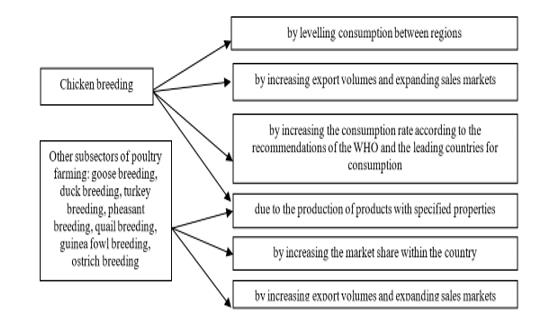
As can be seen from the presented diagram, the MP of poultry egg products will expand towards species diversity and exports, and in the domestic market, these structural shifts in the segmentation of target markets will occur due to an increase in the share of egg processing.
Recommended directions for expanding the MP in poultry egg farming allowed us to predict specific values for each of the assortment groups, which are presented in Figure 5.
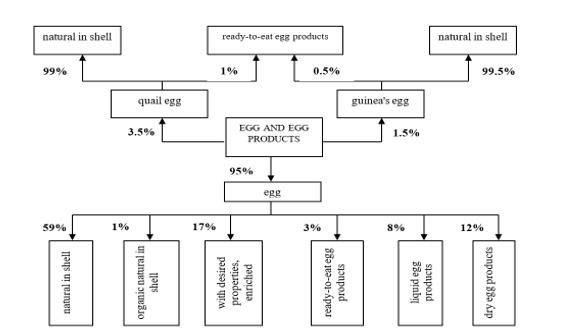
Based on these values, an information map was formed, which is visualized in the form of a geometric figure of an inverted isosceles trapezoid, shown in Figure 6.
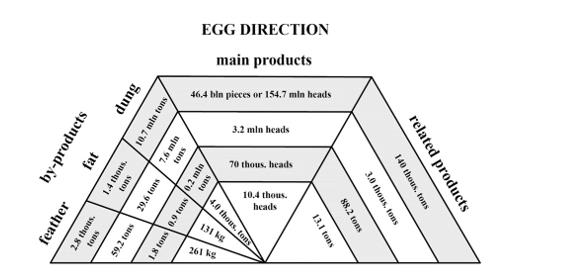
The presence of such an information card in a changing market environment is an effective tool for making management decisions on the segmentation of this target segment in order to improve the efficiency of the functioning of the economic entities of the industry, focused on the strategy of meeting consumer demands.
Conclusion
The systematization and generalization of the MP of the poultry egg industry indicate that there are reserves for its expansion. As the main directions of filling the existing market niches of this segment, such aspects are considered: the alignment of regional levels in self-sufficiency in these types of products, an increase in the share of their processing, an increase in the production of products from other types of poultry, and an increase in export interventions in foreign trade transactions. Decisions on the effective implementation of the identified reserves for expanding MP in egg poultry farming largely depend on the ability to determine these values by types of products. In the course of the research, issues were identified that require theoretical and practical developments, namely, a conceptual model of the interrelationship of industry entities in the production of eggs and their processing products, taking into account its hierarchy, a methodology for assessing the MP of egg poultry farming with its subsequent adaptation to obtain predicted values by species of the obtained products (main, accompanying, secondary), taking into account the proposed scheme of directions for expanding this segment of the target market of eggs and products of their processing. The universality of these scientific developments lies in the possibility of their adaptation to other subsectors of animal husbandry.
References
Barancheev, V., & Strizhov, S. (1996). Analysis and assessment of the marketing potential of the enterprise. Marketing, 5, 33-41.
Cherkasov, V. V. (2012). Market potential of Russian industrial enterprises in the system of factors of long-term economic growth. Economic Policy, 5(90), 6-19.
Dankvert, S. A., & Holmanov, O. Yu. (2014). International trade in live agricultural animals. Despondent. Economics.
Eremeeva, N. A., & Roiter, L. M. (2019). Conceptual model of the relationship between the subjects of the industry in the production of poultry products. Agricultural Economics of Russia, 10, 36-41.
Eremeeva, N. A., Roiter, L. M., & Pavlova, I. M. (2020). Market potential of poultry meat. Russian Agricultural Economics, 3, 69-79.
Eremeeva, N., Roiter, L., & Roiter, Ya. (2019). Mechanisms for implementing the market potential of production made of waterfowl (Mecanismos para implementar el potencial de mercado de la producción de aves acuáticas). Esacios, 40(25).
Fisinin, V. I. (2019). World and Russian poultry farming realities and challenges of the future: monograph. M: Khlebprodinform.
Harutyunyan, A. G. (2010). Development of the market for poultry products. Diss. Cand. econom. sciences. Moscow, 172.
Kakushkin, A. (2017). The niche of egg products remains free. Agroinvestor, 1, 38-41.
Nekrasov, A. V. (2009). Market potential as a tool for managing regional printing enterprises. Diss. Cand. econom. sciences. Omsk.
Popov, E. V. (2002). Market potential of the enterprise. M.: Economics.
Roiter, Y. S., Eremeeva, N. A., & Roiter, L. M. (2019). Market potential of breeding and commercial products in poultry farming. IOP Conference Series: Earth and Environmental Science Krasnoyarsk Science and Technology City Hall of the Russian Union of Scientific and Engineering Associations, 22082.
Valov, I. I. (1999). Formation of the market potential of an aviation enterprise: Dis. Cand. econom. sciences. SPb.
Copyright information

This work is licensed under a Creative Commons Attribution-NonCommercial-NoDerivatives 4.0 International License.
About this article
Publication Date
25 September 2021
Article Doi
eBook ISBN
978-1-80296-115-7
Publisher
European Publisher
Volume
116
Print ISBN (optional)
-
Edition Number
1st Edition
Pages
1-2895
Subjects
Economics, social trends, sustainability, modern society, behavioural sciences, education
Cite this article as:
Roiter, L., Eremeeva, N., Roiter, Y., & Vedenkina, I. (2021). Methodology For Assessing And Forecasting The Market Potential Of Egg Poultry Farming. In I. V. Kovalev, A. A. Voroshilova, & A. S. Budagov (Eds.), Economic and Social Trends for Sustainability of Modern Society (ICEST-II 2021), vol 116. European Proceedings of Social and Behavioural Sciences (pp. 957-967). European Publisher. https://doi.org/10.15405/epsbs.2021.09.02.107

